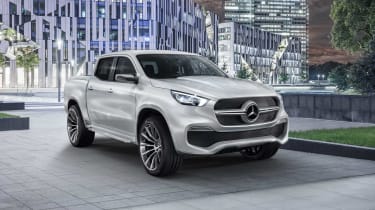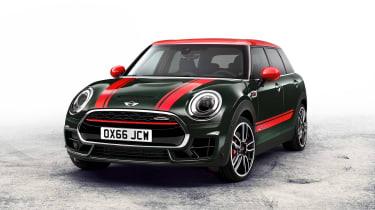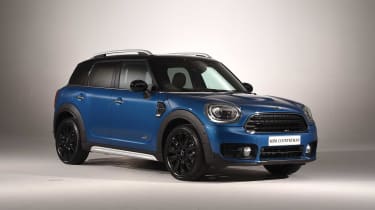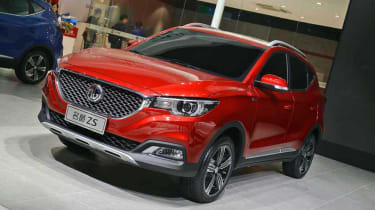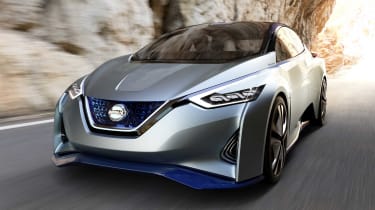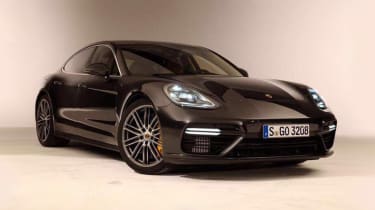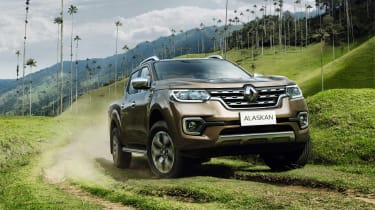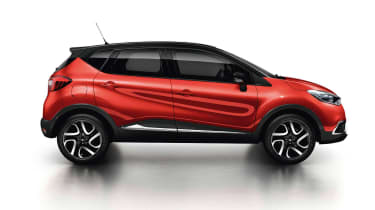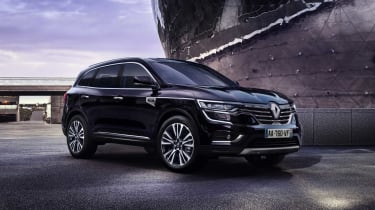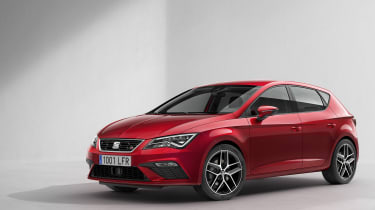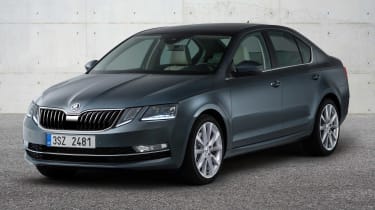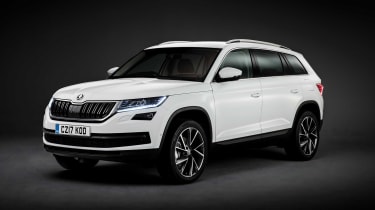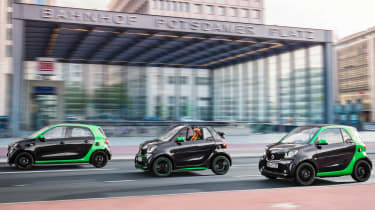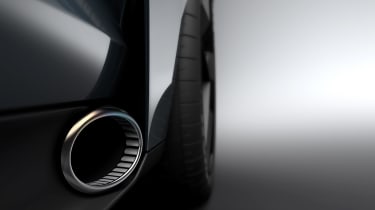New cars 2017: a complete guide
Looking to buy a new car in 2017? Here are the dates and details for the most anticipated new car releases of the year.
Page 2: Ford, Honda, Hyundai, Infiniti, Jeep, Kia, Land Rover, Mercedes
Page 3: MINI, Nissan, Peugeot, Porsche, Renault, Skoda, Smart, TVR, Vauxhall
MINI Clubman JCW
The biggest MINI yet is about to move into hot estate territory. The MINI Clubman John Cooper Works serves up a substantial 228bhp, so it’ll be a credible rival for the Ford Focus ST estate and Skoda Octavia vRS estate. Befitting a car with a £30,000 price tag, it’ll come with four-wheel drive, sporty styling upgrades, a 6.3-second 0-62mph time and a 148mph top speed. The four-wheel drive system can vary the amount of power sent to each wheel to increase grip and stability, and the suspension and brakes have been beefed up to cope with the extra performance. Standard kit will include sat nav and hands-free boot access, although as this is a MINI, you can expect a long list of options, too.
MINI Countryman
The MINI range never remains static for long, and 2017 will see the return of the MINI Countryman range to act as the sole SUV offering in MINI’s line-up. The previous Countryman looked somewhat contrived and the new car has a far more obvious kinship with the MINI hatchback, stretching the established, beloved styling hallmarks of BMW’s baby onto a larger, more practical SUV frame. Its well-resolved looks conceal the fact the new car has grown slightly in each direction compared to its predecessor to become a rival for the Audi Q3 and Audi Q2 SUVs. Inside, the new car follows themes familiar from the hatchback, but with unique touches to the air vents, materials and trims. Along with petrol and diesel engines, a plug-in hybrid Cooper S Countryman E ALL4 has been confirmed to join the range.
MG ZS
The Chinese-owned MG range will continue to expand in 2017. We’ve already seen the MG GS – a medium-sized SUV to rival the Renault Kadjar and Nissan Qashqai – and it’ll be joined in 2017 by the smaller MG ZS, which will rival the Nissan Juke. It’ll be based on the same platform as the GS and use the same range of engines, although a new 1.0-litre turbocharged petrol has also been announced and is likely to roll out across the rest of the MG range soon. Styling is set to be less divisive than the hatchback-coupe of the Juke, but MG can be excused for not taking any risks. The brand’s desire to develop in the SUV class is common knowledge now and the platform of the GS could also underpin a larger vehicle, so the ZS and GS could be joined by a bigger sister before long.
Nissan Juke
The year 2017 will mark the seventh birthday of the Nissan Juke, a car whose success even its maker couldn’t possibly have foreseen. With rivals now rushing to release Juke rivals of their own, a new Juke is required to ensure the Japanese brand isn’t beaten at its own game. Although its styling won’t wander too far from the path that made the original Juke irresistible to so many buyers, its platform will be all-new and related to the underpinnings of the 2017 Nissan Micra, with more efficient petrol and diesel engines as well as a hybrid version on the cards. The interior is also due a total rethink, with soft-touch materials and a clean new design, likely influenced by the next Micra. Infotainment technology will be enhanced by Apple Carplay and Android Auto, while – crucially – there’ll be more room in the rear seat compared to the somewhat cramped current model. The UK has another reason to celebrate the new Juke – it’ll be built alongside the next Micra at the company’s Sunderland plant in the northeast of England.
Nissan Leaf
There’s little doubt that the Leaf has been a huge success for the Japanese company. Over 75,000 examples have been sold in Europe, putting Nissan at the forefront of mass adoption of electric cars. However, the current model has been on the market since 2010 and both design tastes and electric-car technology have developed rapidly since then, so it’s hardly surprising an all-new Nissan Leaf is due. It’s expected in 2017, with the latest high-capacity batteries offering a range in excess of 300 miles between visits to a charging point. In place of the concept-car styling that distinguished the original, though, the next Leaf will have a more conventional look likely to broaden its appeal to people who don’t want to be labelled by their choice of car. A choice of different battery capacities is also likely, which will determine the range of each Leaf variant, as well as its purchase price.
Nissan Micra
The Nissan Micra is one of the biggest names in the small-car business. Over four generations, it’s been a staple of driving schools and extremely popular with those seeking a compact, affordable and easy-to-drive supermini. Little is currently known about the new model, but it’ll have sharper styling and is likely to be longer, lower and wider than the current car. We expect interior quality to take a leap (it’s one of the current car’s weakest suits) and there’ll likely be wide scope for customisation. A 1.0-litre three-cylinder petrol engine should be a big seller in the UK, but diesel versions and even a petrol-electric hybrid models are under consideration.
Nissan Qashqai
The Nissan Qashqai will be heavily updated in 2017, with the changes expected to be more than just skin deep. Beyond a restyle, the Qashqai will be one of the first cars to offer Nissan’s advanced autonomous technology. Called Piloted Drive, the system will share the work of driving at speeds of up to 80mph, assisting with acceleration, steering and braking. A ‘Premium’ concept was shown this year, hinting that the British-built Qashqai is likely to benefit from stylish optional finishes in a bid to take the compact SUV further upmarket. This will increase the Qashqai’s appeal to those who mightn’t previously have considered a Nissan.
Peugeot 5008
The name might be familiar, but the car won’t be. The new Peugeot 5008 has morphed from an MPV into an attractive SUV and will compete with the likes of the Nissan X-Trail and Skoda Kodiaq when it goes on sale in spring 2017. The interior is equally as striking and will feature Peugeot’s new i-Cockpit system, which replaces the instruments with a configurable 12.3-inch screen. Peugeot claims the new 5008 is one of the most practical models in its class, and retains the seven-seat layout of its predecessor. A range of engines will be offered, including 1.2 and 1.6-litre petrols and two 1.6-litre diesels, with the latter almost certainly being the biggest sellers in the UK.
Porsche Panamera estate
The Porsche Panamera estate will be a surprise to people who think of Porsche as a maker of lightweight, powerful sports cars. Despite Porsche’s performance-car heritage, its best-selling car is the Cayenne SUV and it makes sense for the world’s most profitable carmaker to continue to build cars that sell well. The Panamera estate will launch shortly after the new Porsche Panamera executive hatchback and is likely to be called the Sport Turismo. A range of powerful petrol and diesel engines will offered across the Panamera range, and Porsche is expected to further develop the hybrid technology of the current Panamera S E-Hybrid.
Renault 5
Launched in 1972, the original Renault 5 became one of most successful cars of its kind thanks to its low price and a clever design that made the most of its small size. It was also one of the first mass-production cars to feature a hatchback boot – something we’ve come to take for granted since then. In resurrecting the 5’s name – 20 years since production ceased – Renault will focus primarily on efficiency. While the Renault 5 is likely to cost about the same as the popular Renault Clio, it’ll be built using all-new mechanical parts and have engines likely to achieve class-leading fuel-economy. Renault is also working hard to ensure the 5’s interior is one of the most high-tech around when it goes on sale next year. A plug-in hybrid version is likely to be offered, too.
Renault Alaskan
Pickup trucks are becoming increasingly big news in the UK and Renault is poised to release its own entry in this increasingly lucrative field in the shape of the Renault Alaskan. Renault has an alliance with Japanese carmaker Nissan and the Alaskan sits on the same base as the Nissan Navara, with styling that recalls the well-received Renault Captur SUV. Engines for UK versions will be shared with the popular Renault Master van, with bigger engines for the wider global market. Available initially in four-door double-cab format, the Alaskan is expected to be well equipped, offering greater comfort than you might expect from a working vehicle.
Renault Captur
Renault’s Captur SUV will also be given a thorough going-over for 2017. Exterior changes will include the adoption of Renault’s attractive corporate nose treatment with its prominent central diamond badge, while inside we expect an improvement in material quality in line with the increasingly impressive standards Renault has attained. The Captur will also receive an upgrade to its on-board technology in the form of an updated touchscreen infotainment system, bringing it in line with rival systems. Although no new engines have been announced, the petrol and diesel Captur are already very efficient, and further improvements to fuel economy are likely, as is a reduction in CO2 emissions
Renault Koleos
The Renault Koleos is the final and largest member of the French brand’s 2017 SUV line-up. Alongside the Alaskan pickup, the Koleos is another fruit of the alliance between Renault and Nissan, sharing its structure and some components with the Nissan X-Trail SUV. Unlike the Nissan, the Koleos will only be sold with five seats, although it benefits from a larger boot than its sister model, at 624 litres. The Koleos is likely to share engines with the smaller Kadjar SUV, including a 1.2-litre petrol and diesels of 1.5 and 1.6-litre capacities. Four-wheel drive will also be available with certain engines. We expect CO2 emissions and fuel economy to be very competitive for the SUV class, while interior technology and build quality should match Renault’s impressive recent standards.
SEAT Arona
The industry was surprised by just how successful the Nissan Juke has become, so other brands are now scrambling to serve up their own interpretation of the compact hatchback-coupe-SUV recipe. The SEAT Arona adds more appeal to the Spanish marque’s rapidly growing portfolio. It’s a compact crossover that shares its mechanical basis with the SEAT Ibiza hatchback, which will also be all-new for 2017. The two new cars will likely share interior components and technology, as well as engines – although the Arona will take styling cues from the larger SEAT Ateca SUV. There’s no word yet on a four-wheel-drive version and the Arona is likely to be best enjoyed on tarmac. A hot Cupra version hasn’t been mentioned, either, but such a model would make an interesting rival to the Nissan Juke Nismo.
SEAT Leon
The SEAT Leon family hatchback is one of our favourite cars in its class and it’s likely to get only detail updates in 2017. However, SEAT is an increasingly desirable marque and resting on its laurels wouldn’t work in the Spanish firm’s favour. Hence the strong-selling Leon is expected to be brought in line with the attractive styling of SEAT’s increasingly broad range of hatchbacks and crossovers. Inside, changes will focus on quality and technology, with the infotainment system set to integrate Apple Carplay and Android Auto to match systems in rival cars. The Leon range is comprehensive and the updates are set to reach the five-door hatchback, SC three-door hatchback, ST estate and X-perience off-road estate models, too – as well as the Leon Cupra hot hatchback.
SEAT Ibiza
SEAT is part of the huge Volkswagen Group, whose brand portfolio also includes Bentley, Lamborghini and Skoda. Among all these famous names and desirable products, the SEAT Ibiza is now one of the oldest designs on the books. Accordingly, 2017 will mark the arrival of an all-new SEAT Ibiza, again based on a version of the MQB platform that underpins the Volkswagen Golf. It’s expected that the Ibiza will resemble the styling of its bigger Leon brother, while echoing SEATs latest corporate identity as expressed by the Ateca and upcoming Arona crossover – which is itself derived from the new Ibiza. Although engines aren’t expected to change much from the current car, SEAT has hinted the Ibiza’s platform could allow the use of plug-in hybrid power. The next Ibiza range should be at least as broad as the present one, with economical and high-performance models offered.
Skoda Octavia
The current Skoda Octavia has been a huge success for the Czech brand, which has done a good job of keeping it competitive with talented rivals. However, it’ll get an update in 2017 to bring it in line with the edgier look of the Skoda Kodiaq SUV, which will also appear on the larger Skoda Superb. Beyond the exterior makeover, it’s also likely Skoda will make efforts to improve interior fit and finish, while bringing in-car technology up to date. Apple Carplay and Android Auto will be added to the Octavia’s infotainment system, matching the connectivity of rival cars. Although no changes have been announced to the engine line-up, it seems likely that a petrol-engined GreenLine model will be released, offering improved real-world fuel economy.
Skoda Kodiaq
The Skoda Kodiaq is the firm’s second SUV, sitting above the hugely successful Skoda Yeti in its range. The Kodiaq is Skoda’s take on the new Volkswagen Tiguan and SEAT Ateca. It’s a five-seater as standard, but seven seats are available as an option. Without them, boot space measures an impressive 720 litres; with them, the room drops to 630 litres – still more than enough for most. Two petrol and three diesel engines will be offered, but most UK buyers will likely be drawn to the diesels, particularly the 148bhp version. A plug-in hybrid version could be offered in future, to drive down both emissions and running costs.
Skoda Karoq
The Skoda Kodiaq isn’t the only new SUV from the Czech carmaker this year. The Skoda Yeti – the first car the company offered that didn’t fit the mould of saloon, hatchback or estate – is set to be replaced by an all-new model. The name is new, too – the Yeti replacement will be called Karoq and will closely resemble a scaled-down version of the Kodiaq. This means mature, sharp and upmarket looks in place of the rather playful appearance of the outgoing car, but comfort, economy and quality should see a welcome boost. Engines and running gear will be shared with the Volkswagen Tiguan and SEAT Ateca, and a hybrid version is likely to be offered later. If the Kodiaq corresponds with the Skoda Superb in its maker’s range, the Karoq can be seen as an SUV alternative to the Skoda Octavia, bringing the range up-to-date and in line with the company’s latest corporate design language.
Smart ForTwo and Smart ForFour Electric Drive
Smart was once one of the go-to brands if you were looking for something compact for city driving. However, it’s since lost ground to the likes of the Volkswagen up! and Toyota Aygo. The Electric Drive versions of the Smart ForTwo, Smart ForTwo Cabrio and Smart ForFour could change that. Launching early in 2017, they mark the first time Smart will have offered electric versions of its entire range. Smart claims the two and four-seaters will be able to cover 100 miles on a charge, which will take 45 minutes from a fast charging station, or six from a household socket. We expect them to cost from around £15,000, once the government’s £4,500 plug-in grant has been deducted.
TVR coupe
British sports-car maker TVR ceased operating in 2006 due to financial difficulties, but is set to return in 2017. In news that’ll please fans of the much-loved make, the all-new TVR will be built with super-strong and lightweight carbon-fibre technology, with input from McLaren F1 designer Gordon Murray. TVR has confirmed its new car will feature a 480bhp 5.0-litre V8, reach 200mph and cost under £90,000.
Vauxhall Insignia Grand Sport and Insignia Sports Tourer
Vauxhall has pulled out all the stops for its new Insignia Grand Sport, which has lost a fair amount of weight over its predecessor and gained a significant amount of style in the process. Despite this, like for like price comparisons show the new Insignia Grand Sport is a fair bit cheaper than the car it replaces, and the range starts at just over £17,000. All models come with an infotainment touchscreen, Apple CarPlay, keyless entry and go and Vauxhall’s OnStar concierge service, and the cheapest engine is an all-new 1.5-litre turbo-petrol, which should be smooth, pokey and pretty economical. Those after more practicality are catered for by the Insignia Sports Tourer estate, which is no less stylish than its hatchback sibling, though it’s about £1,500 more expensive to buy.
Vauxhall Crossland X
Following on from the huge success of its Mokka X SUV, Vauxhall is launching the smaller Crossland X SUV crossover later this year. Vauxhall’s rival to the popular Renault Captur and Peugeot 2008 is – like those cars – likely to come exclusively in front-wheel drive format, which will help keeps prices and running costs down. Inside, the Crossland X closely resembles the latest Vauxhall Astra, so you should get a sleek, well made and generously equipped car. No official word on pricing yet, but we expect the Crossland X to be priced from around £15,000 when it goes on sale later this year.
Vauxhall Grandland X
The Grandland X continues Vauxhall’s ‘X’ naming strategy for its SUVs and, when it arrives later in 2017, will go up against the Nissan Qashqai and Ford Kuga. While scant details are available for the Grandland X, we expect it to sit on the same mechanical platform as latest Vauxhall Astra - so it should be comfortable and impressive to drive. The Grandland X is likely to be priced from around £18,000 when it goes on sale in the second half of 2017.
Volkswagen Arteon
The Volkswagen CC four-door coupe will be replaced by the new Volkswagen Arteon before the end of the year. With a more distinct identity than its predecessor, the Arteon aims to move VW upmarket, taking sales from the Mercedes E-Class by appealing with sharp styling and cutting-edge driver-assistance systems. These will include an active cruise control system that can adjust speed when it knows a corner is ahead, and headlamps that adjust for bends using sat-nav data. The Arteon will also place considerable emphasis on safety – it’ll take over if it senses you’re incapacitated, slowing the car and safely pulling over to the roadside while alerting other road users to a hazard. The Arteon promises to be very comfortable, too, with more headroom than the outgoing CC and a contoured rear seat that prioritises those in the two outer seats. The Arteon is set to complement the Volkswagen Touareg SUV towards the top of the brand’s line-up, and you can find out what it's like by reading our full review.
Most Popular

Car tax: VED rates and increases explained 2024/25

New Jaguar GT teased: upcoming EV looks like no Jag that’s come before

Ford EcoBoost engines: reliability, problems and should you buy one?
Tips & advice

Car dashboard warning lights: what does each symbol mean?

Electric car charging stations: public networks, charger types, apps and maps


